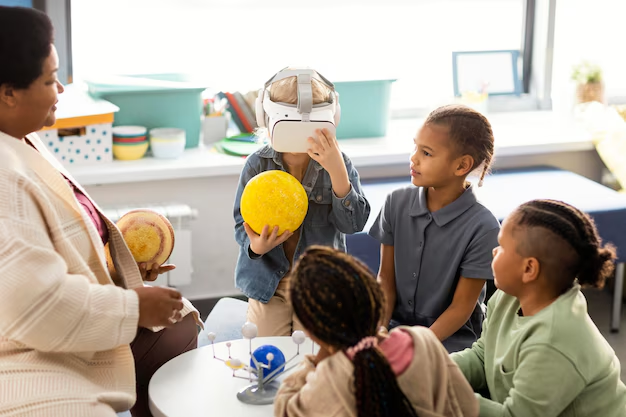
1. Embrace Active Learning
Overview:
Active learning involves students in the learning process through discussions, problem-solving, and hands-on activities.
Implementation:
- Use group projects or peer teaching.
- Incorporate think-pair-share activities.
Benefits:
Active learning encourages critical thinking and deeper understanding of the material.
2. Differentiate Instruction
Overview:
Differentiated instruction tailors teaching methods to meet the diverse needs of students.
Implementation:
- Use varied instructional strategies (visuals, hands-on activities, and lectures).
- Offer choices in assignments and assessments.
Benefits:
This approach ensures all students can engage with the content at their own level.
3. Integrate Technology
Overview:
Technology can enhance engagement and facilitate personalized learning.
Implementation:
- Utilize educational apps and online collaboration tools.
- Implement interactive whiteboards or virtual reality experiences.
Benefits:
Technology not only makes learning more engaging but also prepares students for a tech-driven world.
4. Foster Collaborative Learning
Overview:
Collaboration among students promotes communication and teamwork skills.
Implementation:
- Use group projects, discussions, and peer review sessions.
- Encourage students to work in diverse groups.
Benefits:
Collaboration builds social skills and enhances learning through diverse perspectives.
5. Implement Project-Based Learning
Overview:
Project-based learning (PBL) centers on students working on real-world problems or projects.
Implementation:
- Develop projects that align with curriculum goals and student interests.
- Encourage creativity and critical thinking.
Benefits:
PBL enhances engagement and provides students with practical applications of their learning.
6. Utilize Formative Assessment
Overview:
Formative assessment helps educators monitor student progress and adjust instruction.
Implementation:
- Use quizzes, exit tickets, and peer assessments.
- Provide regular feedback to students.
Benefits:
Frequent assessments allow for timely interventions and help students take ownership of their learning.
7. Create a Positive Classroom Environment
Overview:
A supportive classroom atmosphere encourages student engagement and risk-taking.
Implementation:
- Establish clear expectations and routines.
- Foster respect, trust, and open communication.
Benefits:
A positive environment reduces anxiety and increases student motivation.
8. Incorporate Culturally Responsive Teaching
Overview:
Culturally responsive teaching values students’ cultural backgrounds in the learning process.
Implementation:
- Include diverse materials and perspectives in your curriculum.
- Encourage students to share their cultural experiences.
Benefits:
This approach fosters inclusivity and makes learning more relevant to all students.
9. Encourage a Growth Mindset
Overview:
A growth mindset promotes the belief that abilities can be developed through effort and perseverance.
Implementation:
- Praise effort, not just results.
- Share stories of resilience and learning from failure.
Benefits:
Students develop resilience and a love for learning when they see challenges as opportunities.
10. Promote Social-Emotional Learning (SEL)
Overview:
SEL helps students understand and manage their emotions, set goals, and build relationships.
Implementation:
- Integrate SEL activities into your daily routine.
- Use role-playing and group discussions to address social-emotional topics.
Benefits:
SEL enhances student well-being and academic success by promoting emotional intelligence.
11. Offer Flexible Learning Spaces
Overview:
Flexible learning spaces adapt to different teaching methods and student needs.
Implementation:
- Rearrange furniture to support group work and discussions.
- Create areas for quiet study, collaboration, and hands-on activities.
Benefits:
Flexible spaces enhance student comfort and engagement, promoting a more dynamic learning environment.
12. Utilize Real-World Connections
Overview:
Connecting learning to real-world situations increases relevance and engagement.
Implementation:
- Invite guest speakers from various professions.
- Incorporate field trips or virtual experiences related to the curriculum.
Benefits:
Real-world connections make learning more meaningful and motivate students to apply their knowledge.
13. Provide Choice in Learning
Overview:
Offering students choices empowers them and fosters intrinsic motivation.
Implementation:
- Allow students to select project topics, presentation formats, or reading materials.
- Offer varied pathways to demonstrate learning.
Benefits:
When students have a say in their learning, they are more likely to engage deeply and take responsibility.
14. Encourage Reflection
Overview:
Reflection helps students consolidate their learning and develop critical thinking skills.
Implementation:
- Use journals, group discussions, or exit tickets to prompt reflection.
- Ask students to consider what they learned and how they can apply it.
Benefits:
Reflection fosters metacognition and helps students become more self-aware learners.
15. Build Strong Relationships
Overview:
Strong teacher-student relationships are foundational for engagement and learning.
Implementation:
- Take time to know your students and their interests.
- Provide support and encouragement consistently.
Benefits:
When students feel valued and understood, they are more likely to engage in the learning process.
Conclusion
Implementing these 15 proven strategies can significantly transform your classroom into an engaging and dynamic learning environment. By empowering educators with the tools and techniques to foster student engagement, we can create a culture of collaboration, innovation, and growth. Embrace these strategies to inspire your students and help them realize their full potential in an ever-changing world.
This comprehensive approach provides a valuable resource for educators seeking to enhance their teaching practices and engage their students effectively. If you need more detailed sections or specific examples for any of these strategies, let me know!
